The Eight Culinary Traditions of China & the Dishes You Have to Try
Chinese cuisine has a history that is steeped in tradition. These traditions vary as you move across the land; influenced by the diverse geography and available resources. China being as big as it is has nearly infinite options for what you may find, even on a village-to-village basis. Even with so many different traditions, eight stood above the rest and today are classified as the Eight Cuisines of China. Read more to find out key information about each cuisine, useful vocabulary words and, of course, a delicious recipe for you to have a go at these delicious traditions.

Bai-Qie Chicken is a classic dish of Guangdong Cuisine — Try the recipe, via The Woks of Life, below
Guangdong Cuisine (aka Cantonese Cuisine)
This style of cooking prefers braising, stewing, and sautéing over the flash-fry method that foreigners usually associate with Chinese food. As a result, dishes are quite tender and the original flavours of the ingredients are kept intact. The characteristically sweet taste of the dishes are a result of the sauces commonly used with this cuisine.
Fast Facts
- Most Popular Sauces: Hoisin Sauce (thick, pungent, sweet and salty), Oyster Sauce (thick, sweet and salty, hint of oyster flavour), Plum Sauce (light brown, sweet and sour, made from plums), and Sweet & Sour Sauce
- Most Popular Ingredients: Spring Onions, Sugar, Salt, Rice Wine, Cornstarch, Soya Bean, Sesame Oil
- This cuisine uses all types of ingredients indigenous to the region, meaning you might find snake, cat, or anteater on your dinner plate
Key Vocabulary Words
Cantonese Cuisine: 广东菜 | Guǎngdōng Cài
Preserved Ingredients: 腌渍品 | Yānzì Pǐn
Hoisin Sauce: 蚝油 | Háoyóu
Guangdong Region: 广东地区 | Guǎngdōng dìqū
Cantonese Poached Chicken: 白切鸡 | Bái Qiè Jī
Try this recipe:
Bai Qie Ji — Cantonese Poached Chicken
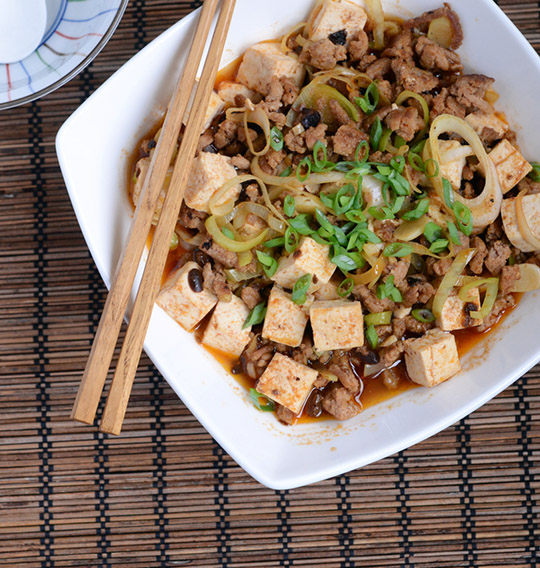
Mapo Tofu, is considered comfort food from the Sichuan Region. Check out the recipe, via Appetite for China, below
Sichuan Cuisine (aka Chuan Cuisine)
Sichuan Cuisine is the most widely served of all of China’s regional cuisines. Originating from Chengdu and Chongqing, this cuisine’s trademark spicy-sour, pungent flavour comes from liberal use of the Sichuan Pepper and Chili Oil. Dishes are primarily made by stir-frying and steaming, but a full list of the preparation techniques would clock in at twenty.
Fast Facts
- Sichuan Pepper has an “intensely fragrant, citrus-like flavour and produces a ’tingly-numbing’” that is often described as feeling similar to a carbonated beverage or light electrical current (see below for the Chinese!)
- Most Popular Sauces: Guaiwei (sesame and sour flavor), Mala (spicy and peppery flavor)
- Most Popular Ingredients (besides Sichuan Peppers): Garlic (and LOTS of it), Peanuts, Ginger, Star Anise, and Broad Bean Chili Paste
- Chengdu was declared a “city of gastronomy” by UNESCO in 2011
Key Vocabulary Words
Sichuan Cuisine: 四川菜 | Sìchuān Cài
Sichuan Pepper: 花椒 | Huājiāo (literally translates to flower pepper)
Gastronomy: 烹饪法 | Pēngrèn Fǎ
Tingly-Numbing (sensation produced by Sichuan Pepper): 麻 | Má
Mapo Tofu: 麻婆豆腐 | Mápó Dòufǔ
Kung Pao Chicken: 宫保鸡丁 | Gōngbǎo Jīdīng
Try this recipe:
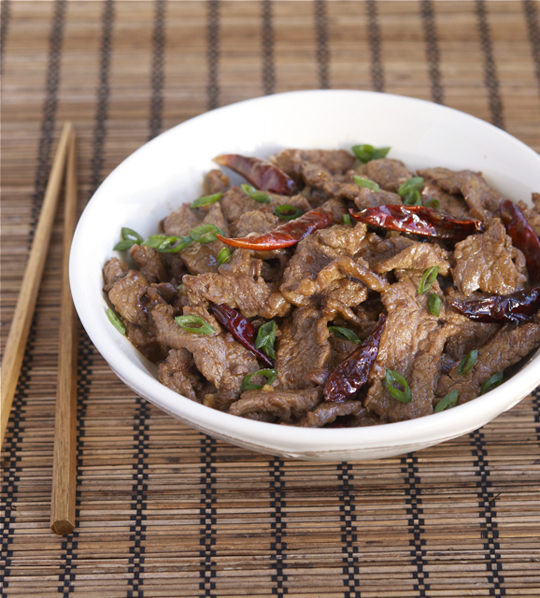
This Hunan Beef dish is spicy, but it won’t stop you from eating it — the flavours are incredible in this quintessential Hunan dish! Try the recipe, via Appetite for China, below
Hunan Cuisine (aka Xiang Cuisine)
Hunan Cuisine is recognizable by its rich, moist, and creamy dishes that almost always contain a potent punch of Chili. This region was historically referred to as “Land of the Fish and Rice”, a name representative of the region’s abundant agricultural output. As a result of this abundance, dishes utilize local, seasonal ingredients which contribute to the low cost of this cuisine compared to the other regions. The most common methods of cooking include sautéing, stir-frying, steaming and smoking.
Fast Facts
- Dishes are known for being “dry hot” as opposed to the “numbing-hot” of Sichuan Dishes
- The temperature of entrees change with the seasons: during the humid summer, a meal generally starts with cold dishes or a selection of cold meats with chilies to open up the pores; in Winter “Hot Pots” are a common choice, commonly thought as being able to warm the insides
- Recipes a liberal use of seasonings that
- The richness of flavor is from the liberal use of seasonings that recipes employ
- Most Popular Seasonings: soy sauce, tea seed oil, spicy oil, Chinese red pepper, fennel and cassia bark
Key Vocabulary Words
Dry Hot: 干辣 |
Xiang Cuisine: 湘菜 | Xiāng Cài
Hunan: 湖南 | Húnán
The Land of Fish and Rice: 鱼米之乡 | Yúmǐzhīxiāng
Hot Pot: 火锅 | Huǒguō
Try this recipe:
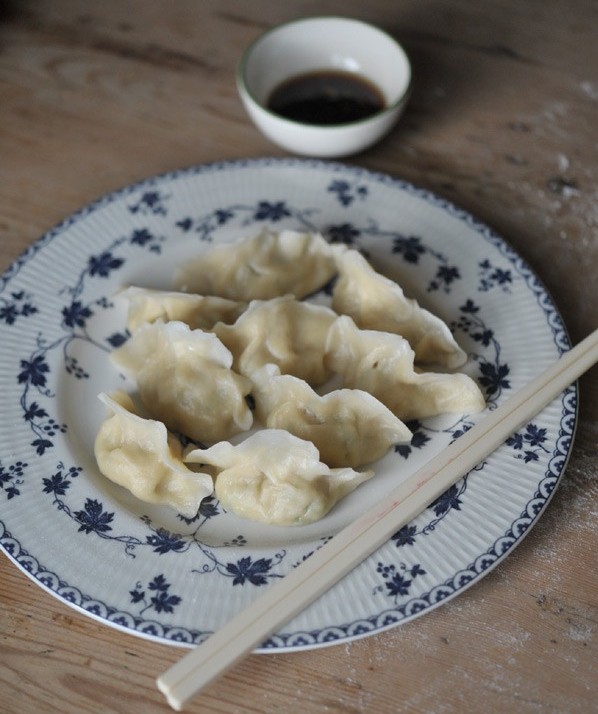
Shandong-style Jiao Zi, or dumplings, have dried shrimp added giving it the hallmark salty flavor of the sea that Shandong dishes are known for. Try the recipe, via Chubby Hubby, below.
Shandong Cuisine (aka Lu Cuisine)
With historical roots that can be traced back to the Qin Dynasty (221 to 207 BC), Shandong cuisine immensely influenced other region’s cuisines as they developed in later years. This cuisine is popular throughout Beijing, Tianjian and the rest of Northeast China. Dishes focus on preserving the freshness of the seafood caught along the Shandong Coast, keeping the natural salty flavor intact. Common methods of preparation are the quick-fry and deep-fry, which creates the distinctive crispy texture of the dishes.
Fast Facts
- This cuisine has had great foundational influence on all of China’s cuisines given its history dating back to the Qin Dynasty
- There are two styles within the Shandong Cuisine: Jiadong-style (seafood dishes with light flavor) and Jinan-style (characterized by the use of soup in its dishes)
- Most Popular Ingredients (besides seafood): Maize, Peanuts, Grains and Vinegar
Key Vocabulary Words
Shandong Cuisine: 山东菜 | Shāndōng Cài
Lu Cuisine : 鲁菜 | Lǔ Cài
Qin Dynasty: 清代 | Qīng Dài
Maize: 玉米 / 玉蜀黍 | Yùmǐ/ Yùshǔshǔ
Quick-Fry: 快炒 | Kuài Chǎo
Chinese Dumplings: 饺子 | Jiǎo Zi
Try this recipe:
Jiao Zi — Shandong Style Dumplings

Fujian-style Fried Rice has a potent kick of savoury flavor from the addition of dried scallops. Try the recipe, via DayDayCook, below.
Fujian Cuisine (aka Min Cuisine)
The Fujian Province is located in Southern China, and its diverse geographical features are reflected by the combination of seafood and woodland-based ingredients. Dishes have a lighter flavour, with an emphasis on umami — the category of taste that represents ‘savoury’. Almost every dish is served with soup; there’s an old saying from the region, “It is unacceptable for a meal to not have soup”. The main cooking techniques include stir-frying, baking, and quick-frying.
Fast Facts
- Particular focus is placed on the chef’s knife skills; this enhances the texture of the dishes
- Fermented Fish Sauce is the prevailing sauce, known locally as “Shrimp Oil”
- Consists of four styles:
- Fuzhou: the lightest taste of the styles, often has a sweet and sour flavour
- Western Fujian: slightly spicier taste from oft-used mustard and pepper
- Southern Fujian: spicy and sweet, with an elabourate selection of sauces utilized
- Quanzhou: the least oily of the styles but has the strongest flavour; great emphasis is placed on the aesthetic of the dish
- “Drunken” dishes, which means the dish has been prepared with Red Wine are some of the most nationally popular dishes of the cuisine
Key Vocabulary Words
Min Cuisine: 闽菜 | Mǐn Cài
Umami: 鲜味 | Xiānwèi
Fermented Fish Sauce: 虾油 | Xiā Yóu
Drunken Dish: 醉(鸡) | Zuì (Jī)
Fried Rice: 炒饭 | Chǎofàn
Try this recipe:
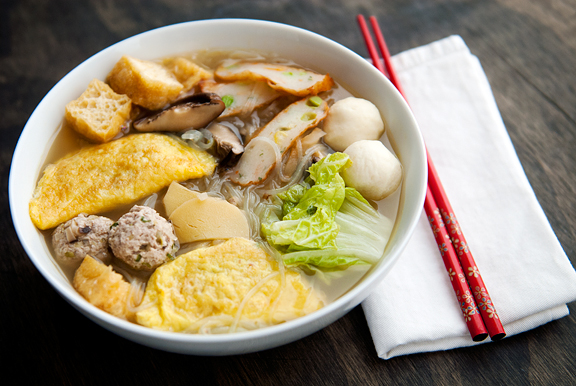
Egg Dumplings are unique: a mix between an omelette and a traditional dumpling, they particularly shine when served with a soup. Try the recipe, via Use Real Butter, below.
Hui Cuisine (aka Anhui Cusine)
The Hui Cuisine is a bit tricky to define: it consists of three different styles from across the region with dramatically different flavours and techniques. For the purpose of this article, I am going to focus on the Southern Anhui style. The Southern Anhui region is in She County, where the famous Yellow Mountains are located. This landscape is rich in natural resources; as such, dishes prominently utilize wild plants and animals. The main methods of cooking are stewing and utilizing a lot of oil.
Fast Facts
- The emphasis on ultra-fresh ingredients makes this the healthiest of the cuisines
- Wild herbs collected from the mountains are one of the more notable features of this cuisine
Key Vocabulary Words
Hui Cuisine: 淮扬菜 | Huái Yáng Cài
Southern Anhui: 皖南 | Wǎnnán
Yellow Mountains: 黄山 | Huángshān
Try this recipe:
Jiangsu Cuisine (aka Su Cuisine)
Despite being composed of six unique styles, the Jiangsu cuisine shares a few common characteristics as a whole.The Yangtze River snakes throughout the region, providing chefs of all styles an abundance of freshwater fish; other ingredients strictly adhere to the season. The taste is fresh, and generally has a salty-sweet flavour with the texture being “soft and thick”. Dishes are often cooked using the earth around them, including slow-baking over an open fire and skillful braising in mud.
Fast Facts
- Seasonal vegetables include watershield, lotus, Chinese chestnut, winter bamboo shoots, water bamboo and water chestnuts
- Huaiyang is the most notable of the six styles for its meals that are planned around one main ingredient with each individual dish meticulously plated for an aesthetically pleasing dining experience
- Additional emphasis is placed on matching shapes, achieved through precise knife work, and serving soup with each meal to enhance the dining experience
Key Vocabulary Words
Jiangsu Province: 江苏省 | Jiāngsū Shěng
Yangtze River: 长江 / 扬子江 | Chángjiāng/ Yángzǐjiāng
Seasonal Ingredients: 季节性食材 | Jìjié Xìng Shícái
Precise Knifework: 精准的刀功 | Jīngzhǔn De Dāo Gōng
Red Braised Pork Ribs: 红烧排骨 | Hóngshāo Páigǔ
Try this recipe:
Hongshao Paigu — Red Braised Pork Ribs
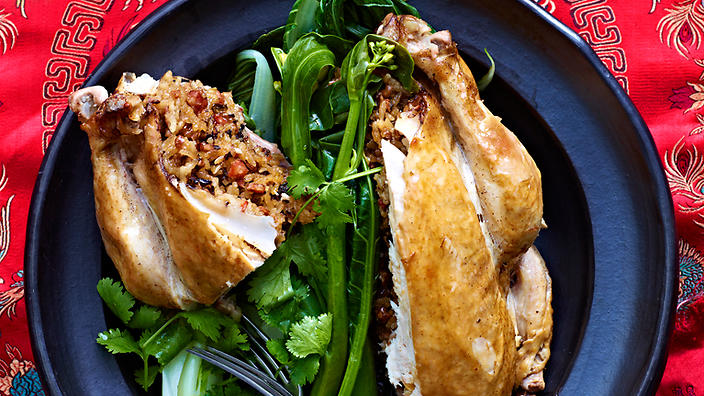
According to legend, a beggar was cooking this chicken recipe on the road. The aroma was so magnificent that an emperor passing by stopped and asked for the recipe so he could add it to the Imperial Court menu. Waft in the royal-approved aroma by cooking this recipe, via SBS, below.
ZheJiang Cuisine (aka Zhe Cusine)
This region is located at the Yangtze River Delta, colloquially referred to as“the Land of Milk & Honey”. With a mellow and non-greasy flavour, this cuisine prominently features freshwater fish in its dishes, just as the Jiangsu cuisine does, provided by the Yangtze River. Additional supplementary ingredients are added with the purpose of mellowing out the fishy smell and cutting greasiness. The main methods of cooking are quick frying, stir-frying, braising and deep-frying
Fast Facts
- Nearly half the dishes in this cuisine include bamboo shoots, which adds a tender element
- The cuisine consists of three major styles; each style originating from a city in the province: Hangzhou style, Ningbo style and Shaoxing style
Key Vocab Words
Zhejiang Cuisine: 浙江菜 | Zhèjiāng Cài
Yangtze River Delta: 长江三角洲 | Hángjiāng Sānjiǎozhōu
The Land of Milk & Honey: 牛乳和蜂蜜的国度(流奶与蜜之地) | Niúrǔ Hé Fēngmì De Guódù (Liú Nǎi Yǔ Mì Zhī Dì)
Fishy Smell: 鱼腥味 | Yú Xīng Wèi
Bamboo Shoots: 竹笋 | Zhúsǔn
Beggar’s Chicken: 叫化童鸡 | Jiàohuā Tóng Jī
Try this recipe:
Enjoyed this blog post, but want to take your Chinese Learning a step further? We think you will love ChinesePod’s fun and easy Mandarin Chinese online lessons. Try it for free.
Karl Ryan
Latest posts by Karl Ryan (see all)
- 7 Apps That Can Score You a Date in China - July 5, 2016
- 22 Things You Can Burn for Qing Ming Festival - March 30, 2016
- Speak the 3rd Tone Like a Native: Say It Like a Kardashian - March 24, 2016
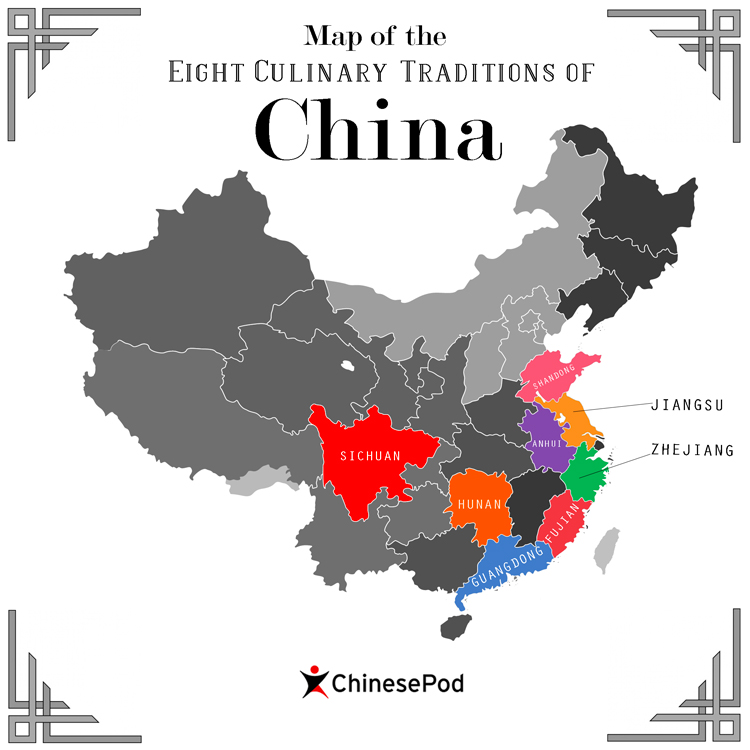
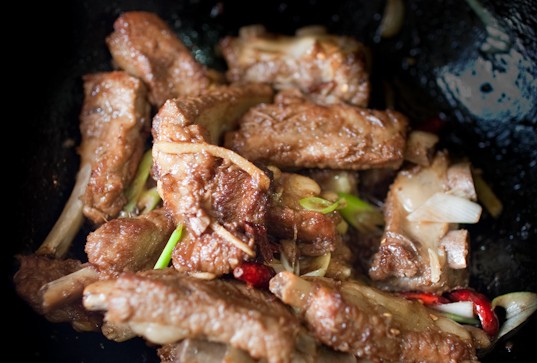



TommyTrue
June 23, 2015 @ 4:36 pm
Under Shandong cuisine you translated it as 清代 when I believe you meant 秦朝. Great informative post!
epale
August 21, 2015 @ 9:58 pm
Cantonese cuisine is better known within China as “yue cai” or Yue cuisine. As in other provinces mentioned there are other variations as Chaozhou cai, kejia cai, etc.
huangsihan
December 28, 2015 @ 11:59 am
中国八大菜系(Eight major cuisines of China):鲁Lu(山东 Shan dong)、 川 Chuan(四川 Si Chuan)、 粤Yue(广东 Guang dong)、 闽Min(云南Yun Nan)、 苏 Su(江苏Jiang Su)、 浙Zhe(浙江 Zhe Jiang)、湘Xiang(湖南 Hu Nan)、 徽Hui(安徽 An Hui)。